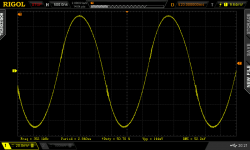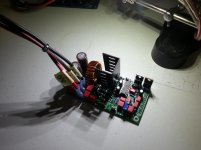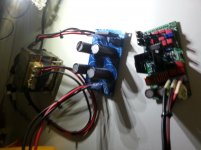A cup of coffee or tea is always a good idea...
I looked again to your screen shot and started to scratch my head about the frequencies. Is the displayed 200us the time per grid or the entire sampling time?
Must go to bed now, but will be here tomorrow again.
I looked again to your screen shot and started to scratch my head about the frequencies. Is the displayed 200us the time per grid or the entire sampling time?
Must go to bed now, but will be here tomorrow again.
A cup of coffee or tea is always a good idea...
I looked again to your screen shot and started to scratch my head about the frequencies. Is the displayed 200us the time per grid or the entire sampling time?
Must go to bed now, but will be here tomorrow again.
200uS per division, the bottom is just calculations for the transfer function.
Great stuff hopefully it will be fixed by then, thanks for the help thus far everyone
OK, then the direction as posted in #278 is good for searching.200uS per division
Only if there is definitely everything right then we would have to extend the search.
Your reading of a few single Ohms between Pin 3 and GND (Pin2) is definitely suspicous.
My sample shows approx 10k.
Note: The readings from my DMM can be different with your DMM, because it depends on the DMM signal levels which are used if/how much the non linear paths in transistors, diodes and inside IRS will influence the reading.
But a few single ohms there are definitely not correct and also have the potential to run a low oscillation frequency dominated by the filter resonance.
OK, then the direction as posted in #278 is good for searching.
Only if there is definitely everything right then we would have to extend the search.
Your reading of a few single Ohms between Pin 3 and GND (Pin2) is definitely suspicous.
My sample shows approx 10k.
Note: The readings from my DMM can be different with your DMM, because it depends on the DMM signal levels which are used if/how much the non linear paths in transistors, diodes and inside IRS will influence the reading.
But a few single ohms there are definitely not correct and also have the potential to run a low oscillation frequency dominated by the filter resonance.
Okay, I think I found the problem.
1) The cause for the first malfunction was R7, it was fitted with a 7.0R instead of a 27k, the 7.0R resistor found its way with my 27k batch, and I missed it. (This is also why I got erratic oscillating bursts) 😱
2) The first malfunction, silently killed the second FET (verified this as it was reading 200R between gate and drain), which was causing the over-current condition, I assume the 4 second reset bursts was an indication of that.
3) IRS2092 is dead as a result of #2, 1 ohm between PIN 2 and 3.
The hard part is removing the FETS, as the mechanical stress may end up damaging the board / via barrel, vie been very gentle and got all of the holes clean.
This is rather embarrassing but its okay, at least I owned up, I goofed up 😱
Now I need to order the parts again, learn from my mistakes and get the project up and running.
Okay, I think I found the problem.
1) The cause for the first malfunction was R7, it was fitted with a 7.0R instead of a 27k, the 7.0R resistor found its way with my 27k batch, and I missed it. (This is also why I got erratic oscillating bursts) 😱
...
Fine that you got it running! 🙂
BTW: I always double check all parts before and after soldering using a "Smart Tweezer (st5)". It is expensive but it saved many days of my rare spare time and helps me keeping my assembling success rate high.
Using this tool I've assembled 9 (nine!) LiteAmp's without any troubles.
Definitely something for a
 wishlist. 😉
wishlist. 😉BR, Toni
Fine that you got it running! 🙂
BTW: I always double check all parts before and after soldering using a "Smart Tweezer (st5)". It is expensive but it saved many days of my rare spare time and helps me keeping my assembling success rate high.
Using this tool I've assembled 9 (nine!) LiteAmp's without any troubles.
Definitely something for awishlist. 😉
BR, Toni
Hey Toni
Thanks, funny I was looking at that tool just last week, and may end up saving up for it.. yes you have an impressive build, and 9 of these boards no joke to assemble and maybe cause vertigo after assembling the 3rd board.
Okay, I think I found the problem.
1) The cause for the first malfunction was R7, it was fitted with a 7.0R instead of a 27k...
Yup, this fits.
Amazing - when I put this in my simulation, then I am not just seeing that the system is falling into a low frequency oscilation. This parameter is even worse, it is leading to an oscilation which stabilizes between 15A..30A peak, depending on component tolerances and stiffness of supply.
Means it can happen that this generates max stress in the entire power stage over long time - and just does not trigger the shut down... or triggers the shut down only seldom.
Somehow you experienced an unfair portion of bad luck with this assembly error.
Unfortunately I have sold out my stock and so I cannot simply sent further components to you - hoping you will find a local source!
If all this does not work, I can offer to add IRS2092 and IRFI4212 with my next order at Mouser or Digikey (not planned yet, but likely to happen again within six months....)
Yup, this fits.
Amazing - when I put this in my simulation, then I am not just seeing that the system is falling into a low frequency oscilation. This parameter is even worse, it is leading to an oscilation which stabilizes between 15A..30A peak, depending on component tolerances and stiffness of supply.
Means it can happen that this generates max stress in the entire power stage over long time - and just does not trigger the shut down... or triggers the shut down only seldom.
Somehow you experienced an unfair portion of bad luck with this assembly error.
Unfortunately I have sold out my stock and so I cannot simply sent further components to you - hoping you will find a local source!
If all this does not work, I can offer to add IRS2092 and IRFI4212 with my next order at Mouser or Digikey (not planned yet, but likely to happen again within six months....)
Hi Marcus, thanks for the help, would like a copy that simulation would be interesting to play with. looking at that resistor it looks like it forms a pole which at 7.0R probably dropped the frequency to a value thats features that resistor as almost non existent... bah! trust me to introduce silly drama 😛
As for the components, lucky for me RS does stock both the IRFI4212 AND IRS2092 so im in luck. thanks for the offer though.
IRFI4212H-117P | International Rectifier IRFI4212H-117P Dual N-channel MOSFET Transistor, 11 A, 100 V, 5-Pin TO-220 | International Rectifier
IRS2092PBF | IRS2092PBF, Audio Amplifier Class-D 9MHz 60dB +125 C 16-Pin PDIP | International Rectifier
..would like a copy that simulation would be interesting to play with. looking at that resistor it looks like it forms a pole which at 7.0R probably dropped the frequency to a value thats features that resistor as almost non existent... bah! trust me to introduce silly drama 😛
OK. Time is mature to disclose another brick in the wall.
For my modeling of the IRS2092 I copied parts of my older modeling of the IRS20957 and adapted it by the OTA and comparator behavior.
The SIM reflects the fundamental behavior of the IRS2092 including OTA and the ugly internal slow but flippy comparator behavior. Also the black box behavior of total propagation delay and level shifting. Dead time can be parametrized by the delay differences of the transmission lines. Not included are the shut down functions of the IRS. Also the entire simulation does not model PCB parasitics.
Don't get confused with the component namings, they are not harmonized with the PCB and LiteAmp builder data. But I am sure you will find the corresponding components.
For the MosFets I selected types, which are similar to two paralleled IRFI4212.
For simulation that's pretty close to reality. Last detail tuning of THD and switching events up to now always has to be done with the real thing.
Attachments
Very cool! Thank you for sharing; interesting table values on E3.
I'm having very little time for DIY these days so all my projects are on hiatus. Perhaps in the fall. (This weekend's the first I've looked at DIY Audio in some time, actually.)
I'm having very little time for DIY these days so all my projects are on hiatus. Perhaps in the fall. (This weekend's the first I've looked at DIY Audio in some time, actually.)
OK. Time is mature to disclose another brick in the wall.
For my modeling of the IRS2092 I copied parts of my older modeling of the IRS20957 and adapted it by the OTA and comparator behavior.
The SIM reflects the fundamental behavior of the IRS2092 including OTA and the ugly internal slow but flippy comparator behavior. Also the black box behavior of total propagation delay and level shifting. Dead time can be parametrized by the delay differences of the transmission lines. Not included are the shut down functions of the IRS. Also the entire simulation does not model PCB parasitics.
Don't get confused with the component namings, they are not harmonized with the PCB and LiteAmp builder data. But I am sure you will find the corresponding components.
For the MosFets I selected types, which are similar to two paralleled IRFI4212.
For simulation that's pretty close to reality. Last detail tuning of THD and switching events up to now always has to be done with the real thing.
I ordered X10 MOSFETS x5 IRS2092 replacement parts should arrive this week.
In the mean time this simulation should be very useful for educational purpose. No need for the parasitics modelling to be included , I expected that to be a separate model in its own right. 🙂
Thanks Marcus.
New Parts arrived today. 😀 will update with progress.
Okay my amplifier works, after following proper precautions with some diligence. after no signs of over-current was showing I removed the 100R resistors, note only one FET with a small heat-sink is shown during the test.
Will do the mechanical work and the gain board over the weekend.
Many thanks Marcus you been very helpful
 🙂
🙂Attachments
Okay my amplifier works


My congratulations.
...glad that your efforts now turn into fruitful results.

My congratulations.
...glad that your efforts now turn into fruitful results.

Thanks 😀
Amazing how unforgiving self oscillating amplifiers are, one resistor so much drama.
True. And until I saw your headache I thought the LiteAmp would be one of the
more forgiving ones. But obviously it can really be a bad boy.
Anyhow - you tamed the beast.
more forgiving ones. But obviously it can really be a bad boy.
Anyhow - you tamed the beast.
True. And until I saw your headache I thought the LiteAmp would be one of the
more forgiving ones. But obviously it can really be a bad boy.
Anyhow - you tamed the beast.
I remembered, eva saying her amplifiers employ some interesting protection features, one of them was a PIC micro-controller that monitors class-d amplifier switching frequencies, and other sophisticated things which today's generation microcontrollers can do with ease.
I'm even looking at setting up a STM32F4 168MHz to do some dsp stuff like an Parametric EQ, IIR Filter and some other interesting things,if this works, I may drop the gain boards and use the dsp attachment instead, as my application is subwoofer specific.
I'm even looking at setting up a STM32F4 168MHz to do some dsp stuff like an Parametric EQ, IIR Filter and some other interesting things,if this works, I may drop the gain boards and use the dsp attachment instead, as my application is subwoofer specific.
Hi Reactance,
Actually, I have a STM32F429-DISCOVERY and very interested in a collaborative work.
STM32F7 is coming with more power and better I2S support.
I am still a good C/C++ developper (and many other languages), but few knowledge on filters....
Hi Reactance,
Actually, I have a STM32F429-DISCOVERY and very interested in a collaborative work.
STM32F7 is coming with more power and better I2S support.
I am still a good C/C++ developper (and many other languages), but few knowledge on filters....
Hi camelator,
STM32F7 looks great but I want to suck the last drop of cycles from the F4 floating point unit, before we moving to the F7.
lets respect this thread and not hijack it 🙂
I will PM you later, collaboration sounds great. I will PM you later.
- Home
- Amplifiers
- Class D
- SystemD LiteAmp


